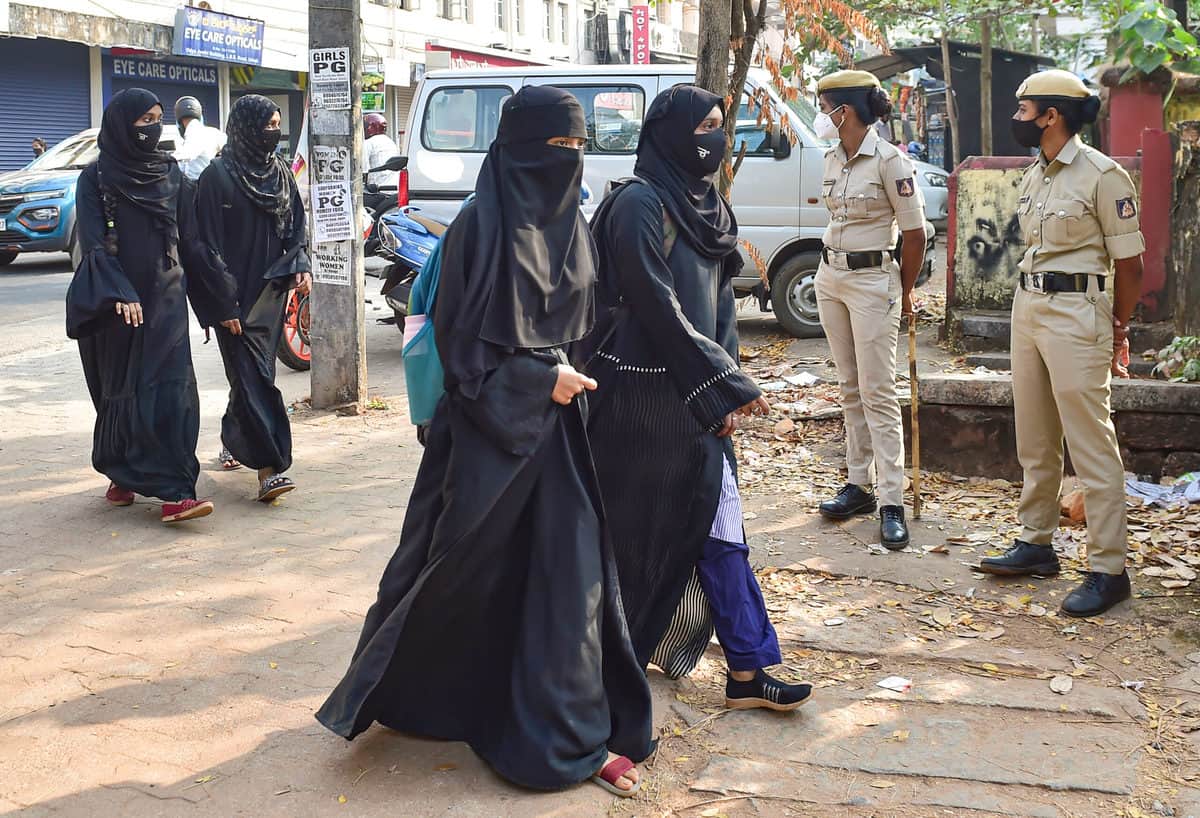
In recent times a political group has been in the news. It has been called names, and there are allegations. The court notes that “suddenly in the middle of the academic term, the issue of hijab was generated in the social media by the activists” (of that group). Does that have a bearing? Promotion, by any group, of a ritual of origin in antiquity, even if not essential practice of that religion, does not denude believers of their religious flavour, nor render the ritual suspect. Neither should it have here. However the verdict is split, so there is hope.
Representations were made by parents and/or students for hijab to be worn in classrooms. There was a counter-reaction. I imagine a blue headscarf vs saffron dupatta counter-reaction. I imagine the State in its wisdom decided if 20 Muslim girls wear blue headscarves, 300 Hindu girls wear saffron dupattas, the Muslim girls will feel overwhelmed, it will exacerbate differences, so it might harm assimilation. If so, explain the Ministerial statement on another religious difference identifier regarding any attempt to prevent wrist threads or tilaks. Who promoted hijab was relevant. This selective caution was not. Since judges leave their affiliations outside courtrooms, we know it is not relevant. The judges have spoken.
“Wednesbury” test, and citing Chairman, J & K State Board of Education v. Feyaz Ahmed Malik on mass malpractice in an examination where the court held in campus discipline of educational institutions, the conduct of examinations the court should not substitute its own views in place of the authorities.” Let me understand: copying in examination in a specific institution requires the court to defer to management’s response, so the court must defer to a no-hijab decision? I thought one was cheating, a matter of discipline, the other expression, a matter of choice. Maybe I am wrong and perhaps both are the same. The judges have spoken, so I stand corrected.
Citing Modern Dental College & Research Centre v. State of MP “right under Article 19 (1) (g) is not absolute but is subject to reasonable restrictions in the interest and welfare of students and to promote merit, achieve excellence and curb malpractices…” Banning hijab is reasonable restriction, promotes merit and excellence? Or can it be equated with examination malpractice?
The court refers to laws that modified Muslim Law (they loosely refer to it as Mohammedan Law, with no thought as to fine distinctions) and mention Special Marriages Act, 1954 where when a Muslim registers marriage under it succession to the property of such Muslim and of issue of such marriage is not to be governed by Muslim Law but by Indian Succession Act. However, nine Judges in Ahmedabad St. Xavier’s College Society held a condition requiring the surrender of a right is as effective a deterrent to the exercise of the right as a direct prohibition. Thus “…the religious minority does not voluntarily waive its right, it has been coerced because of the basic importance of the privilege involved, in that case affiliation, in this, continued education.
Moreover, it was held it, “is doubtful whether the fundamental right – in that case u/Art. 30(1) – can be bartered away or surrendered by any voluntary act or that it can be waived. The reason is that a fundamental right is vested in a plurality of persons as a unit or if we may say so, in a community of persons necessarily fluctuating. Can the present members of a minority community barter away or surrender the right under the article so as to bind its future members as a unit? The fundamental right is for the living generation. …the past members of a community cannot surrender the right of future members of that community.” By registering my marriage under the Special Marriages Act, can I today destroy my born and unborn children’s right to be governed by Islamic Law? Instead of relying on the doubtful, where “two roads diverged in a wood”, the court needlessly took the road less travelled by, precedent and Golden Rule of Harmonious Construction notwithstanding.
Babri Masjid held court should not enter into an area of theology and attempt to interpret religious scriptures. “…inappropriate for this Court to enter upon an area of theology and to assume the role of an interpreter… The true test is whether those who believe and worship have faith in the religious efficacy of the place where they pray. The belief and faith of the worshipper in offering namaz at a place which is for the worshipper a mosque cannot be challenged.” In this labyrinth, the masjid is not essential versus cannot be challenged, try harmonious interpretation. How would anyone decide, if not nudged by what he holds more correct, i.e., his predisposition?
“This Court, as a secular institution, set up under a constitutional regime must steer clear from choosing one among many possible interpretations of theological doctrine and must defer to the safer course of accepting the faith and belief of the worshipper.”
Again, “… practice of religion, Islam no exception, varies according to culture and social context. …strength of our plural society. …accommodating, tolerating and respecting a diversity of religious faiths and ideas. …wearing of hijab may be a ‘religious practice’ or an ‘essential religious practice’ or it may be social conduct for the women of the Islamic faith. The interpretations by the believers …about headscarf is the belief or faith of an individual. Religious belief cannot be carried to a secular school maintained out of State funds. …Thus, the practice of wearing hijab could be restricted by the State in terms of the Government Order.
National Legal Services Authority, held Article 19(1) (a) gave all citizens the right to freedom of speech and expression, which includes the right to expression of self-identified gender. …self-identified gender can be expressed through dress, words, action or behaviour or any other form. No restriction can be placed on one’s personal appearance or choice of dressing, subject to the restrictions contained in Article 19(2) of the Constitution.” So, no restrictions on dress. Do I get creative and argue hijab is not a dress, but a mere accessory?
Devidas Ramachandra Tuljapurkar “having stated about the test that is applicable to determine obscenity we are required to dwell upon the right to freedom of speech and expression. The words, “freedom of speech and expression” find a place in the association words “liberty of thought, expression, belief, faith and worship”, which form a part of the Preamble of the Constitution. The Preamble has its own sanctity and the said concepts have been enshrined in the Preamble. …Article 19(1) (a) is intrinsically linked with Preambular objectives …duty of Court to progressively realise the values of the Constitution.
Shafeeq R. Mahajir is a well-known lawyer based in Hyderabad

